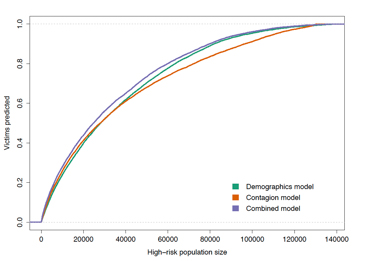
Atul Gawande popularized the concept of medical ‘hot spotting” - originally, hot spotting was the practice of focusing on known crime areas and it became vital for reducing crime in New York City - to health matters in a 2011 article in the New Yorker. Medical hot spotting was using data to identify patterns (models) to identify which groups can be targeted for further intervention pr even prevention. Ben Green, et al., in this week’s JAMA Internal Medicine, extend hot spotting in a new direction, to rampant gun violence in Chicago, so I am wading into an area where the Council has no official position. Here are their highlights:
- While mass casualty assaults get the media play, most gun violence involves two people
- Gun violence is likely to spread immediately after the initial incident and between people linked to the violence
- Statistical models of gun violence typically make use of spatial and temporal factors (bad neighborhoods)
- Victims of gun violence are concentrated in social networks – the set of social relationships or interactions among a set of individuals
- Could social networks replace or augment spatial and temporal factors in ‘predicting’ gun violence? Were there elements of social contagion to gun violence? Was it “that the diffusion of gun violence might occur through person-to-person interactions, in a process akin to the epidemiological transmission of a blood-borne pathogen (eg, HIV).”
Their data set were arrest records and police reports about gun violence in Chicago, a city with three times the national average of gun violence. A social network was fashion based upon co-offenders - individuals arrested together presumably with pre-existing social ties. 30% of people connected to 90% of the network. The network model contained 75% of the gun violence in Chicago during the study period.
The paper compared two models. The traditional demographic model “that assumes becoming a subject of gun violence is determined by traits, such as age, sex and neighborhood residence...approximating traditional risk factor theories of gun violence.” The social network model (contagion model) included the social network of the potential victims ignoring demographic features.
Here are the results: “Overall, the contagion model outperforms the demographics model for the high-risk quarter of the population … while the demographics model outperforms the contagion model for the rest of the population. The combined model reaps the benefits of both models, and performs best across the entire distribution.”

When you look at the absolute numbers, neither model was useful as an actionable predictor of who would become a victim, identifying 7% or less of the highest risk group. But accounting for an individual’s social network did improve the model's predictions.
The takeaway
An underlying assumption within the paper is that it might be relevant to medicalize a discussion of gun violence, with phrasing such as “diffusion of gun violence might occur through person-to-person interactions, in a process akin to the epidemiological transmission of a blood-borne pathogen (eg, HIV).”
The metaphor, while useful, is unsatisfactory, because we have a better epidemiological understanding of infectious disease than of how social networks behave or are even formed. Even our understanding of infections remains deeply flawed, as witnessed by the controversy around both Ebola and Zika ‘epidemics.’
Adding to a lot of confounders about inputs is that medicalizing gun violence would wrongly burden physicians with responsibilities for which they have no training or resources - some activists want to push the medical community into it, which increases cultural pressure at a time when doctors are already under a lot.
Social networks are a composite, surrogate variable. Social networks are influenced by race, gender, where you grew up, your ethnicity, income, and a host of other factors, both known and unknown. They can't be modeled well enough to make good policy yet
However, an important contribution of this article, to my mind, is to help us understand that gun violence is not solely about a button that can be pushed, gun regulation or changing the socioeconomic environment. There are many nuanced contributors, and the social networks people choose could simply be among them. Simplistic ‘solutions’ by any of the popular stakeholders, anti-gun groups, the NRA, police, politicians, do not warrant the certainty their advocates invoke, even though they all latch onto studies that match their beliefs.
Human behavior is far more complex than models can show. However, while complexity should not keep us from trying ‘solutions’ that are based on what we do know right now, they should make us more deferential about the pitfalls, and less strident in our advocacy and discussion.
